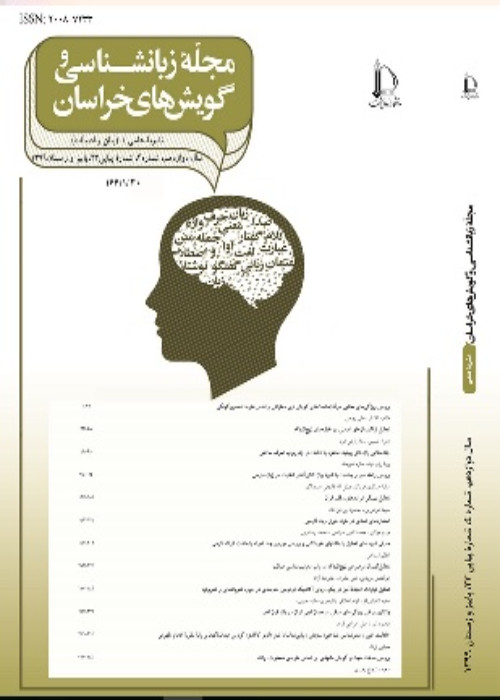The Investigation of Past Perfect in Future Domain
Author(s):
Article Type:
Research/Original Article (دارای رتبه معتبر)
Abstract:
Introduction
The foreign linguists have answered the question of why English speakers use the preterite in complement clauses while using the preterite in head clauses by three hypotheses. It is not possible to argue for or against one of the three hypotheses without incorporating them into a coherent theory of tense. Within Declerck’s theory (1991a), comrie’s hypothesis (1986) is rejected but instead it is accepted that the tense of a complement clause in indirect speech according to the other hypotheses may be either a relative tense or an absolute tense. The study method is descriptive_analytic. The similarity between Persian and English examples, and the limitations governed on them are very amazing. Past perfect is one of the tenses which shows the priority on the past orientation time. The article investigates the past perfect in future domain, that is, when the head clause situation is in future. The data show using past perfect versus present perfect but our selected framework offers a natural explanation for them.Theoretical Framework
Lack of acquaintance in persian makes us just state foreign linguists’ views about tense order and relations, traditionally called Sequence of Tenses (SoT). They offer three different hypotheses to answer the introduction questions. These hypotheses consist of 'absolute tense hypothesis', 'relative tense hypothesis', and 'formal SoT'. Absolut hypothesis says that the subclause situation is in the past tense because it refers to past time. Past tense as an absolute tense form relates a situation (i.e. event, state, etc.) directly to the moment of speaking. Relative hypothesis expresses that the subclause situation is simultaneous with the head clause situation, which lies in the past. Comrie's formal SoT hypothesis says if in direct speech the introductory verb is in past tense, in indirect speech a formal SoT rule automatically backshifts the tense forms from direct speech. Declerck (1990b) rejects Comrie's hypothesis and expresses that the tense of a complement clause in indirect speech may be either a relative tense or an absolute tense. While choosing Declerck’s tense theory (1991a) we see his hypothesis suitable for explaining Persian data. In his theory establishing and extending temporal domains, and the shift of temporal perspective are basic concepts that together with particular Semantics and pragmatics coming from Grice’s Conversation Maxims (1975) help us to find out some aspects of time such as SoT in Persian complex sentences.
Methodology
The study method is descriptive_analytic. In the study we have selected some complex sentences in Persian not needing to be indirect speech so that we can test implicitly the possibility of generation of Declerckʼs theory to the other sentences. The head clause situation is in present or future tense and the subclause prior situation is in present perfect or past perfect tense. The article writers provide a natural explanation for these Persian examples.Discussion
Tense relations consist of priority, simultaneity, and posteriority. This study is an attempt to realize the temporal priority of situations in future domain called post_present domain in Declerck’s theory. The priority in future domain in unmarked case is shown by two pseudo_absolute tenses: pseudo_past and pseudo_present perfect, while in marked case it is indicated by a relative tense: past perfect. It is possible for the subclause situation refered by present perfect to be prior to the head clause situation in the present or future tense; however, using past perfect in this conditions needs to be explained because the past perfect functions as an instruction to look for a past orientation time, to which the situation time can be interpreted as being anterior. If head clause refers to the present or post_present and there is no contextually given past orientation time, it is the beginning of the head clause situation that is interpreted as being the past or pseudo_past orientation time in question. Self-evidently this is only possible if the head clause has a certain duration, so that its beginning can be seen as past with respect to the rest of the situation. Tense priority in the future domain is expressed by past tense or present perfect tense in unmarked case and by past perfect tense in marked case.Conclusion
The similarity between Persian and English examples, and limitations governed on them are very amazing, while studying tense and SoT. The connotation of the similarity is that Persian and English languages follow the same principles which are the representative of the competence universality in spite of their external differences. Furthermore, Persian traditional grammar defines present perfect and past perfect so that it may not have any contrast with the core meaning of them in accepted tense system here, although it does not include all the details. Therefore, studying more about the tense forms assumes necessary.Keywords:
Language:
Persian
Published:
Journal of Linguistics & Khorasan Dialects, Volume:10 Issue: 19, 2019
Pages:
23 to 46
magiran.com/p2012813
دانلود و مطالعه متن این مقاله با یکی از روشهای زیر امکان پذیر است:
اشتراک شخصی
با عضویت و پرداخت آنلاین حق اشتراک یکساله به مبلغ 1,390,000ريال میتوانید 70 عنوان مطلب دانلود کنید!
اشتراک سازمانی
به کتابخانه دانشگاه یا محل کار خود پیشنهاد کنید تا اشتراک سازمانی این پایگاه را برای دسترسی نامحدود همه کاربران به متن مطالب تهیه نمایند!
توجه!
- حق عضویت دریافتی صرف حمایت از نشریات عضو و نگهداری، تکمیل و توسعه مگیران میشود.
- پرداخت حق اشتراک و دانلود مقالات اجازه بازنشر آن در سایر رسانههای چاپی و دیجیتال را به کاربر نمیدهد.
دسترسی سراسری کاربران دانشگاه پیام نور!
اعضای هیئت علمی و دانشجویان دانشگاه پیام نور در سراسر کشور، در صورت ثبت نام با ایمیل دانشگاهی، تا پایان فروردین ماه 1403 به مقالات سایت دسترسی خواهند داشت!
In order to view content subscription is required
Personal subscription
Subscribe magiran.com for 70 € euros via PayPal and download 70 articles during a year.
Organization subscription
Please contact us to subscribe your university or library for unlimited access!



